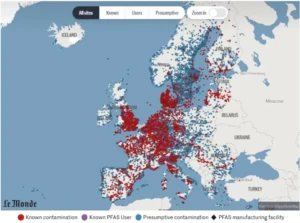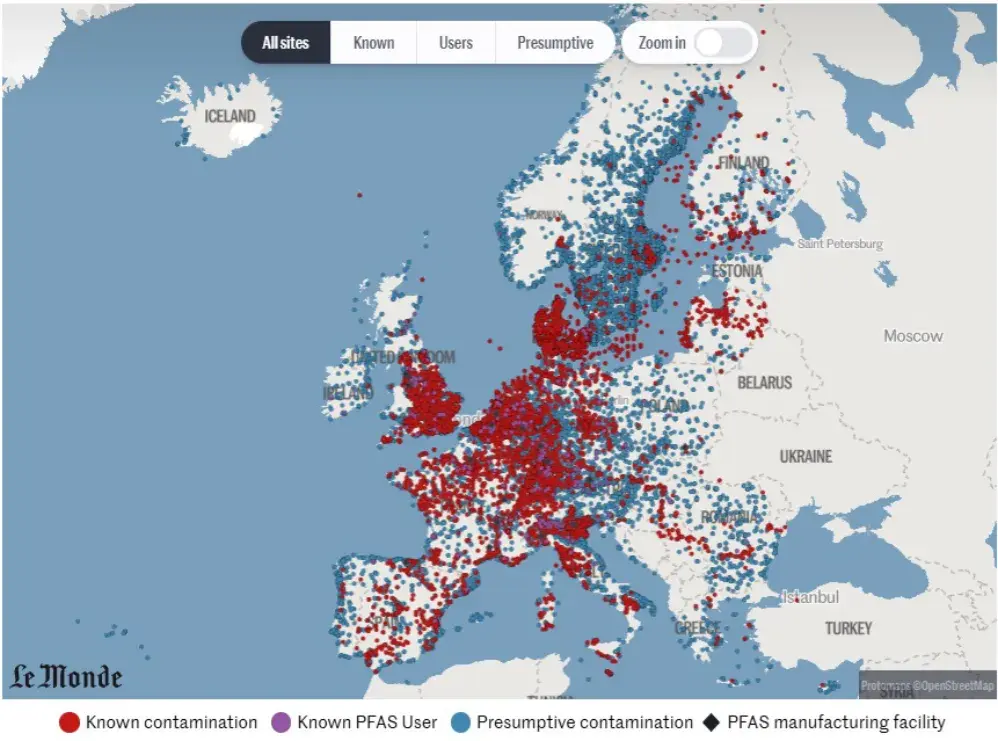A recent report by Générations Futures reveals an important but often overlooked reality: PFAS – known as “forever chemicals” – are not only present due to industrial accidents but are also significantly present into agriculture through pesticides. In the European Union, 12% of the synthetic active substances approved for use in pesticides contain PFAS, compounds renowned for their environmental persistence and resistance to degradation.
Unlike accidental industrial pollution, the use of PFAS in agriculture results from the authorized application of PFAS-based substances in pesticides. While existing regulatory frameworks aim to ensure the safety of agricultural practices, significant gaps remain. Current evaluations often do not fully account for the extreme persistence of PFAS or their potential to accumulate in soil, water, food, and living organisms. Strengthening regulations and adopting a more precautionary approach are therefore crucial steps toward better protecting public health and ecosystems.
PFAS contamination is particularly concerning due to the difficulty of removing these substances once they have entered the environment. Their stability leads to long-term exposure risks for humans and wildlife alike, affecting drinking water, food safety, and biodiversity. As awareness of these risks grows, there is an urgent need for proactive policies that promote alternative agricultural solutions capable of reducing chemical dependencies.
This is where our European project Tribiome offers promising answers.
Tribiome is working to develop and deploy microbiome-based solutions that can help farmers reduce their reliance on synthetic inputs, including pesticides and fertilizers. By harnessing beneficial microbial communities found in soil and plants, Tribiome aims to enhance plant health, resilience, and productivity naturally.
Microbiome innovations offer a sustainable alternative to traditional chemical products, not only protecting crops but also improving soil quality and overall ecosystem balance. These biological solutions align perfectly with the European Green Deal’s objectives: reducing pesticide use, protecting biodiversity, and fostering healthier, more sustainable food systems.
In particular, microbiome technologies offer the potential to address several interconnected challenges:
- Reducing environmental persistence: Unlike synthetic chemicals such as PFAS, biological products are naturally biodegradable.
- Enhancing soil regeneration: Microbiomes contribute to healthier soils that require fewer external inputs.
- Supporting long-term agricultural resilience: Diverse and healthy microbial communities can strengthen plant resistance to pests and diseases without the need for intensive chemical interventions.
To successfully transition towards these alternatives, policy makers have a decisive role to play. Supporting research and innovation projects like Tribiome is critical to accelerate the development, validation, and adoption of safe and sustainable agricultural practices. Furthermore, regulatory frameworks must evolve to better recognize the risks posed by persistent chemicals and to favor nature-based solutions
As the European Union tries to meet its pesticide reduction targets by 2030, it is essential to ensure that systemic and preventive approaches – such as microbiome-based innovations – are given the attention and investment they deserve.
We have opportunity to reshape agriculture towards sustainability, health, and resilience. Let’s act today to ensure a future free from forever chemicals.
➡️ Read the PFAS in pesticides report: Copie de PESTICIDES PFAS
#AgricultureSustainability #MicrobiomeInnovation #PFAS #ForeverChemicals #GreenDeal #PolicyMakers #EnvironmentalHealth #AgTech #EUProjects #NatureBasedSolutions

This Map was last updated on 6 November 2023. An updated and enhanced version of the data was built by the PFAS Data Hub project at the French National Centre for Scientific Research (Centre national pour la recherche scientifique, CNRS). Update : Map | PFAS Data Hub

